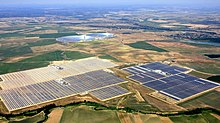
Back طاقة شمسية حرارية Arabic Enerxía solar térmico AST Energia solar tèrmica Catalan وزەی گەرمی خۆر CKB Solarthermie German Ηλιοθερμικά συστήματα Greek Energía solar térmica Spanish Eguzki-energia termiko Basque انرژی حرارتی خورشیدی Persian Aurinkolämmitys Finnish


Solar thermal energy (STE) is a form of energy and a technology for harnessing solar energy to generate thermal energy for use in industry, and in the residential and commercial sectors. Solar thermal collectors are classified by the United States Energy Information Administration as low-, medium-, or high-temperature collectors. Low-temperature collectors are generally unglazed and used to heat swimming pools or to heat ventilation air. Medium-temperature collectors are also usually flat plates but are used for heating water or air for residential and commercial use.
High-temperature collectors concentrate sunlight using mirrors or lenses and are generally used for fulfilling heat requirements up to 300 °C (600 °F) / 20 bar (300 psi) pressure in industries, and for electric power production. Two categories include Concentrated Solar Thermal (CST) for fulfilling heat requirements in industries, and Concentrated Solar Power (CSP) when the heat collected is used for electric power generation. CST and CSP are not replaceable in terms of application.
Unlike photovoltaic cells that convert sunlight directly into electricity, solar thermal systems convert it into heat. They use mirrors or lenses to concentrate sunlight onto a receiver, which in turn heats a water reservoir. The heated water can then be used in homes. The advantage of solar thermal is that the heated water can be stored until it is needed, eliminating the need for a separate energy storage system.[1] Solar thermal power can also be converted to electricity by using the steam generated from the heated water to drive a turbine connected to a generator. However, because generating electricity this way is much more expensive than photovoltaic power plants, there are very few in use today.[2]
- ^ Coren, Michael (February 13, 2024). "Meet the other solar panel". The Washington Post.
- ^ Kingsley, Patrick; Elkayam, Amit (October 9, 2022). "'Eye of Sauron': The Dazzling Solar Tower in the Israeli Desert". The New York Times.